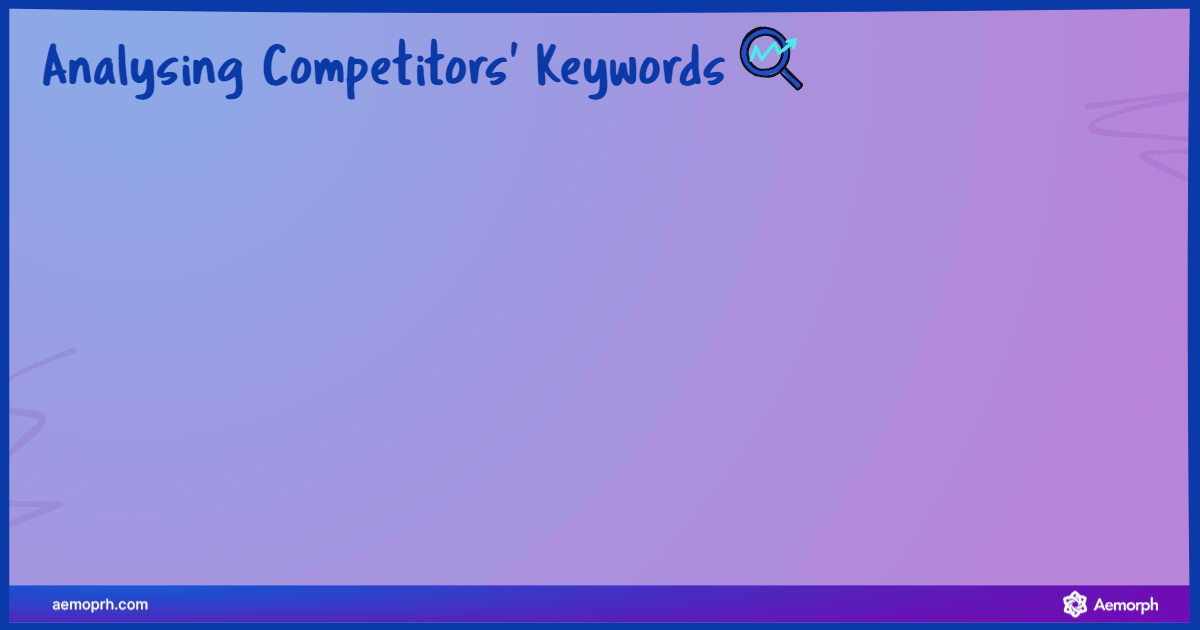In the digital world of search engine rankings, knowing your competitor is a strategic imperative. Competitor analysis is the blueprint for any serious SEO campaign, carving paths to keyword sources, untapped content ideas, and potent link-building strategies.
Understanding the Basics of Competitor Analysis

At the heart of a robust SEO strategy lies competitor analysis, an ongoing study of the key players and their strategies in your niche. It focuses on the performance metrics of your peers, appraising their keyword rankings, content strategies, backlink portfolios, and social media engagement.
Competitor analysis allows you to observe and learn from the tactics and productivity of your competitors.
For example, Aemorph will start doing keyword research with every project we had before writing the content, to know which way we should approach to get the highest benefits out of the content creation. Aemorph will do competitor analysis on every keyword and content idea we had to make layouts for our content. How did we do it?
Step 1: Identifying Your Real SEO Competitors

SEO competitors may not be the same as your business rivals. SEO competitors are the ones who rank for the same keywords, fight for similar traffic, and work on the same digital strategies as you do.
Here’s how to identify your real SEO competitors:
- Cast a wide net: Expand your search queries to include variations of your target keywords. Use tools like Google Keyword Planner.
- Analyse SERPs: Use tools like Ahrefs or SEMrush to note the websites that appear when you search for your keywords.
- Look for overlap: Identify websites that consistently appear in the top 10 search results for multiple keywords.
- Assess domain authority: Consider the domain authority of the websites that appear in the SERPs which ranges from 1 to 100, with higher scores indicating a greater ability to rank using Moz’s Domain Authority tool.
- Analyse content and backlinks: Use tools like BuzzSumo to examine the quality and relevance of the content and backlinks of your potential competitors.
- Use competitive analysis tools: Utilise competitive analysis tools such as SpyFu and SimilarWeb for insights.
- Stay updated: Continuously monitor and reassess your competitors using tools like Rank Tracker as search rankings can change over time.
Make sure to accurately identify your real SEO competitors and develop effective strategies to stay ahead.
Step 2: Analysing Competitors’ Keywords

Utilise SEO tools to identify the keywords driving your competitors’ content to the top of SERPs.
To effectively analyse your competitors’ keyword strategies, adopt a comprehensive approach using various SEO tools and methods:
- Keyword Gap Analysis: Use Ahrefs or SEMrush to compare your keyword portfolio with your competitors to spot the gaps and opportunities using tools such as Ahrefs or SEMrush.
- Analyse Keyword Density: Look at how often competitors use specific keywords on their page, which gives insights into their target keywords using tools like Yoast SEO.
- Keyword Position Tracking: Use rank tracking tools like SERPWatcher or Moz to see where your competitors’ keywords stand in the search engine results pages (SERPs).
- Study Their Content: Read through your competitors’ content to understand keyword context and usage, noting any recurring themes or phrases.
- Long-Tail Keyword Exploration: Don’t overlook the power of long-tail keywords – use Ubersuggest to identify if your competitors are targeting less competitive, niche keywords that can be advantageous.
- Seasonal Keyword Trends: Use Google Trends to observe if there are seasonal patterns to the keywords being targeted and plan your SEO strategy accordingly.
- Paid vs Organic Keywords: Use tools like SpyFu to differentiate between the keywords for which your competitors are ranking organically and the ones they are bidding on in paid search campaigns.
- Check Their Meta Tags: Analyse the keywords used in your competitors’ meta titles and descriptions using Screaming Frog SEO Spider, which can yield insights into their SEO priorities.
Gain a 360-degree view of your competitors’ keyword strategies and adjust your SEO tactics to compete more effectively in the digital space.
Step 3: Evaluating Competitors’ Content Strategy

Content is a key factor in modern SEO. Focus on understanding not just what content your rivals produce, but how strategic, valuable, and shareable it is.
Look for gaps in their content strategy. Are there areas they’ve overlooked or undervalued? These are opportunities for you to fill the gap and outshine them.
- Content Quality and Relevance: Scrutinise the content for its quality and relevance to the target audience. Is it well-written, informative, and engaging?
- Content Types and Formats: Classify the variety of content types utilised — do they leverage blogs, videos, infographics, social media posts or podcasts to attract and retain their audience?
- Frequency of Publishing: Monitor how often your competitors publish new content using content analysis tools like BuzzSumo. A higher publishing frequency can indicate a commitment to keeping their audience informed and engaged.
- User Engagement: Use tools like Hootsuite to assess the level of engagement with the content through likes, shares, comments, and inbound links. High engagement rates often reflect content that resonates well with the audience.
- Content Themes and Topics: Use topic research tools like AnswerThePublic to analyse the themes and topics covered. Are they addressing all the pain points of their audience, or is there an area that you could discard?
- Performance Metrics: Use Google Analytics to measure content performance metrics such as page views, bounce rates, CTA, CTR and time on page to gauge content effectiveness.
- Shareability: Use social media analysis tools like BuzzSumo to consider how shareable their content is, including whether it’s being picked up by industry influencers or shared across social networks.
- SEO Optimisation: Look at how well the content is optimised for SEO with the use of keywords, meta descriptions, header tags, and internal linking strategies using Yoast SEO.
By analysing these components of your competitors’ content strategy, you will be able to spot weaknesses to exploit and strengths to emulate, ultimately guiding the refinement of your content strategy to outshine your competitors.
Step 4: Assessing Backlink Profiles

Backlinks are crucial to SEO, and your competitor’s backlink profile reveals the networks of trust and authority they’ve built. The goal here is to not only analyse their links but also to identify potential link opportunities for your site.
To assess backlink profiles effectively, you must conduct thorough research and utilise a suite of analytical tools. Detailed scrutiny of your competitors’ backlink profiles can uncover valuable insights into their link-building strategies, and here’s how you can go about it:
- Audit Backlink Quality: Quality trumps quantity when it comes to backlinks. Use tools like Moz’s Link Explorer or Majestic to evaluate the authority and trustworthiness of the domains linking to your competitors.
- Analyse Link Types: Differentiate between the types of links – whether they’re do-follow or nofollow, text or image links, and identify which types are contributing most to your competitors’ SEO performance.
- Link Diversity: Inspect the diversity of the backlink profile, including the range of domains, the geographical locations of the links, and the variety of industries that the backlinks come from.
- Referring Domains: Identify the number and quality of referring domains. A higher number of reputable referring domains generally indicates a healthy backlink profile.
- Anchor Text Analysis: Examine the anchor text used in backlinks to gain insights into targeted keywords. Look for signs of over-optimisation, which could be detrimental to SEO.
- Lost and New Links: Track the backlinks that competitors have lost and gained over time. This can indicate the volatility of their backlink profile and opportunities for you to build new links.
- Backlink Growth Trends: Analyse the growth trends of your competitors’ backlink profiles to understand the pace at which they’re acquiring new links.
- Identify Top-linked Content: Review which pieces of content are attracting the most links and ponder on how you can create content of equal or greater link-worthy calibre.
- Competitor Link Acquisition Strategies: Infer the strategies behind link acquisition by observing the types of content and engagement that result in new backlinks for your competitors.
By meticulously assessing these aspects of backlink profiles, you’ll gain actionable insights and a competitive edge in enhancing your SEO strategy.
Step 5: Social Media and Online Presence Review

Engagement and visibility across social media reveal your competitors’ tactics. With the use of tools such as Hootsuite, which provides social media metric tracking, It allows users to monitor and analyse various metrics such as likes, shares, comments, follower growth, and engagement rates across multiple social media channels from a single dashboard.
Focus on best practices to enhance your social media presence. Maintain an authentic voice and brand consistency across platforms. Here’s what you must prioritise:
- Rich and Engaging Content: Create content that is not only relevant to your audience but also encourages interaction and sharing. Use high-quality images, interactive videos, and infographics to increase engagement.
- Regular Posting Schedule: Keep your social media profiles active with a regular posting schedule. Consistency is key to staying on your audience’s radar and keeping the engagement going.
- Audience Interaction: Promptly respond to queries and comments to foster a community and show that you value your follower’s input and feedback.
- Innovative Campaigns and Hashtags: Launch campaigns that spark conversations and use unique hashtags to track engagement and spread the word about your brand.
- Leverage Analytics: Utilise social analytics tools to understand audience behaviour and refine your strategies to cater specifically to what works for your target market.
- Industry Influencers Collaboration: Collaborate with influencers to expand your reach and add credibility to your brand.
- Monitor Trends and Adapt: Keep abreast of the latest trends and be quick to adapt to the changing landscape of social media to keep your content fresh and relevant.
- Advertise Smartly: Make use of targeted advertising to reach specific segments of your audience with messages tailored to their interests and needs.
Apply these best practices to amplify your online presence and establish a competitive edge on social media.
Using Findings to Inform Your SEO Strategy
Step 6: Use Your Findings to Plan Your SEO Strategy
Leverage the information from each of the previous steps to refine your SEO strategy. Incorporate successful elements from your competitors while capitalising on the weaknesses you’ve discovered. Your goal is to create an SEO strategy that’s uniquely powerful and explicitly you.
Turn Into Your Skills
Once you’ve completed Steps 1-5 and gathered information on your competitors’ keywords, content, backlinks, and social media presence, you can use these insights to craft a tailored SEO strategy. Here’s how to do it:
1. Identify Gaps and Opportunities:
- Keyword Gaps: Compare your keyword list to your competitors’. Are there any keywords they rank for that you’re missing? Target these to expand your reach.
- Content Gaps: Analyze your competitors’ content strategy. Are there topics they’re neglecting? Fill those gaps with high-quality content.
- Backlink Gaps: Identify websites linking to your competitors that you could potentially target for your backlinks.
2. Improve Content Quality and Relevance:
- Benchmarking: Use your competitors’ content as a benchmark. Is their content more informative, engaging, or visually appealing than yours?
- Content Updates: Regularly update your older content to keep it fresh and relevant, especially if your competitors are doing so.
3. Optimize for Target Keywords:
- Keyword Usage: Use the keywords you’ve identified in your titles, headers, and body content.
- Keyword Density: Ensure your keyword density is optimal, avoiding over-optimization.
4. Build High-Quality Backlinks:
- Link-Building Strategies: Identify the link-building strategies your competitors are using, such as guest posting, broken link building, or outreach.
- Backlink Quality: Focus on acquiring backlinks from high-quality, authoritative websites.
5. Enhance Social Media Presence:
- Content Sharing: Share your content on social media platforms where your competitors are active.
- Engagement: Interact with your audience and respond to comments promptly, just as your competitors do.
6. Track and Measure:
- Analytics: Use tools like Google Analytics to track your website’s performance and compare it to your competitors.
- Adjustments: Based on your findings, adjust your SEO strategy as needed.
Remember: SEO is an ongoing process. To maintain a competitive edge, continuously monitor your competitors’ strategies and adjust your own accordingly.
BONUS: Best Tools for Competitor Analysis
Tools can significantly impact the effectiveness and efficiency of your competitor analysis.

- SEMrush: A comprehensive tool that offers a wide range of features for competitor analysis, including keyword research, backlink analysis, and site audits. It provides valuable insights into your competitors’ strategies and helps you stay ahead in the game.
- Ahrefs: Another powerful tool for competitor analysis, Ahrefs offers detailed backlink analysis, keyword research, and content gap analysis. It helps you uncover your competitors’ link-building strategies and look for new opportunities to improve your own website’s performance.
- Moz: Moz provides a suite of tools for competitor analysis, including domain analysis, keyword research, and rank tracking. It helps you understand your competitors’ online presence and identify areas where you can outperform them.
- SpyFu: With SpyFu, you can uncover your competitors’ most profitable keywords, ad campaigns, and organic search rankings. It gives you valuable insights into their strategies and helps you optimise your campaigns.
- SimilarWeb: SimilarWeb provides a comprehensive overview of your competitor’s website traffic, including traffic sources, audience demographics, and engagement metrics. It helps you benchmark your performance against your competitors and identify areas for improvement.
- BuzzSumo: BuzzSumo allows you to analyse your competitor’s content performance, including social shares, backlinks, and engagement metrics. It helps you identify popular topics in your industry and create content that resonates with your target audience.
- Majestic: Majestic offers a range of tools for backlink analysis, including site explorer, link profile analysis, and link prospecting. It helps you understand your competitors’ link-building strategies and find opportunities to build high-quality backlinks.
- Serpstat: Serpstat provides comprehensive data on your competitors’ organic and paid search performance, including keyword rankings, ad campaigns, and search volume. It helps you identify gaps in your SEO and PPC strategies and optimise your campaigns accordingly.
- CognitiveSEO: CognitiveSEO offers advanced backlink analysis and content optimisation tools for competitor analysis. It helps you uncover your competitors’ link-building strategies and improve your own website’s visibility in search results.
- Raven Tools: Raven Tools provides a suite of tools for competitor analysis, including website audits, keyword research, and social media monitoring. It helps you monitor your competitors’ online activities and identify opportunities to gain a competitive edge.









